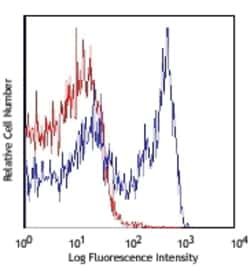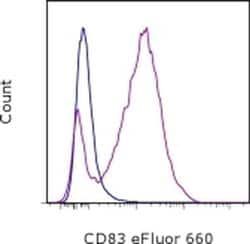LYVE1 Monoclonal Antibody (ALY7), eFluor™ 660, eBioscience™, Invitrogen™
Manufacturer: Fischer Scientific
Select a Size
| Pack Size | SKU | Availability | Price |
|---|---|---|---|
| Each of 1 | 50-164-38-Each-of-1 | In Stock | ₹ 34,651.80 |
50-164-38 - Each of 1
In Stock
Quantity
1
Base Price: ₹ 34,651.80
GST (18%): ₹ 6,237.324
Total Price: ₹ 40,889.124
Antigen
LYVE1
Classification
Monoclonal
Concentration
0.2 mg/mL
Formulation
PBS with 0.09% sodium azide; pH 7.2
Gene Accession No.
Q8BHC0
Gene Symbols
Lyve1
Purification Method
Affinity chromatography
Regulatory Status
RUO
Gene ID (Entrez)
114332
Content And Storage
4° C, store in dark, DO NOT FREEZE!
Form
Liquid
Applications
Flow Cytometry, Immunocytochemistry, Immunohistochemistry (Frozen)
Clone
ALY7
Conjugate
eFluor 660
Gene
Lyve1
Gene Alias
1200012G08Rik; cell surface retention sequence binding protein-1; cell surface retention sequence-binding protein 1; CRSBP1; CRSBP-1; extra cellular link domain-containing 1; extracellular link domain containing 1; extracellular link domain-containing 1; extracellular link domain-containing protein 1; HAR; hyaluronic acid receptor; lymphatic endothelial hyaluronan receptor LYVE-1; lymphatic vessel endothelial HA receptor-1; lymphatic vessel endothelial HA recptor-1; lymphatic vessel endothelial hyaluronan receptor 1; lymphatic vessel endothelial hyaluronic acid receptor 1; LYVE1; LYVE-1; sLyve 1; sLyve1; soluble LYVE 1; soluble LYVE1; UNQ230/PRO263; XLKD1
Host Species
Rat
Quantity
100 μg
Primary or Secondary
Primary
Target Species
Mouse
Product Type
Antibody
Isotype
IgG1 κ
Description
- Description: The monoclonal antibody ALY7 recognizes mouse LYVE-1, a transmembrane glycoprotein with similarity to CD44
- The extracellular domain contains a conserved hyaluro binding domain also found in CD44
- Expression is found on lymphatic and liver endothelial cells and some populations of macrophages
- The lymphatic system is responsible for transporting proteins and cells (especially dendritic cells) to tissues throughout the body, thereby acting as immune surveyors
- LYVE-1 is one characteristic protein, along with podoplanin, PROX-1, Tie-2 and VEGFR-3, that is expressed on lymphatic endothelial cells (LECS)
- The ligand for LYVE-1 is hyaluro, a large mucopolysaccharide
- Although LYVE-1 can bind hyaluro in vitro, the site for ligand binding in vivo is masked by sialyated O-linked glycan chains
- It is postulated that binding to ligand requires modification/unmasking to expose the binding site
- The development and remodeling of the endothelium after injury is an area of extensive study
- When transplanted, hematopoietic stem cells (HSCs) can give rise to LECs that integrate into the endothelium in normal and metastatic tissue
- Applications Reported: This ALY7 antibody has been reported for use in flow cytometric analysis and immunohistology staining of frozen tissue sections
- Applications Tested: This ALY7 antibody has been tested by flow cytometric analysis of transfected cells or IHC on mouse tissue
- This can be used at 1-10 μg/mL for IHC
- LYVE1 has been identified as a major receptor for HA (extracellular matrix glycosaminoglycan hyaluronan) on the lymph vessel wall
- The deduced amino acid sequence of LYVE1 predicts a 322-residue type I integral membrane polypeptide 41% similar to the CD44 HA receptor with a 212-residue extracellular domain containing a single Link module, the prototypic HA binding domain of the Link protein superfamily
- Like CD44, the LYVE1 molecule binds both soluble and immobilized HA
- However, unlike CD44, the LYVE1 molecule colocalizes with HA on the luminal face of the lymph vessel wall and is completely absent from blood vessels
- Hence, LYVE1 is the first lymph-specific HA receptor to be characterized and is a uniquely powerful marker for lymph vessels themselves
- LYVE1 is a type I integral membrane glycoprotein
- LYVE-1 is expressed primarily on lymphatic vessel endothelium and is likely to be involved in regulating the traffic of leucocytes and tumor cells to lymph nodes
- The lymphatic vasculature forms a second circulatory system that drains extracellular fluid from the tissues and provides an exclusive environment in which immune cells can encounter and respond to foreign antigen
- A number of molecules have been identified as markers for lymphatic endothelium which include LYVE1, PALE, VEGFR3, and podoplanin
- Diseases associated with LYVE1 dysfunction includes Complete Androgen Insensitivity Syndrome.



